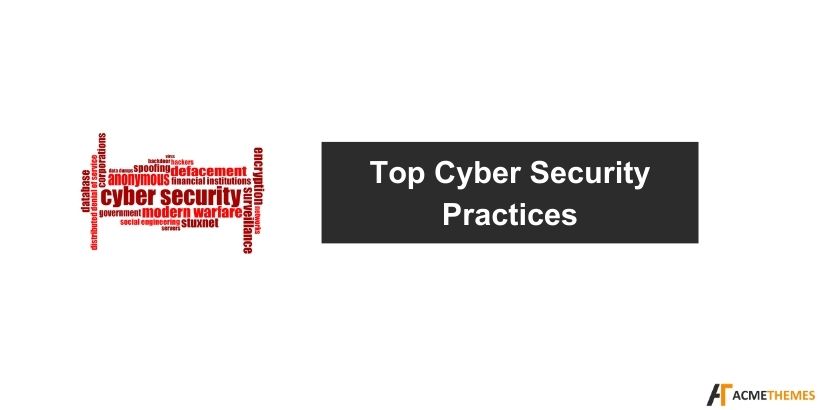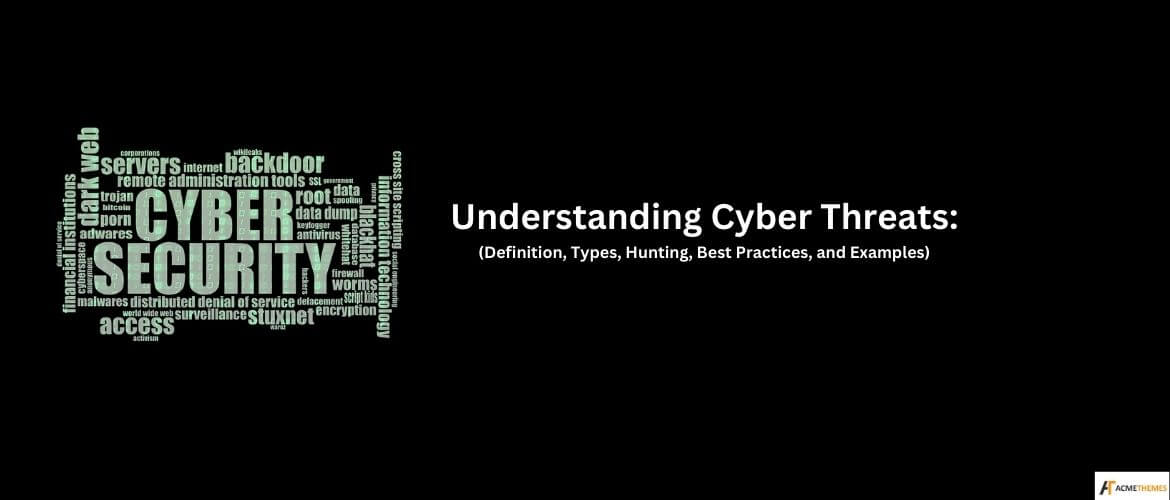Understanding Cyber Threats: Definition, Types, Hunting, Best Practices, and Examples
In the modern era of constant connectivity, the term “cyber threat” has gained widespread recognition, highlighting the potential hazards and difficulties that come with being heavily reliant on technology. The goal of this article is to clarify the concept of cyber threats, utilizing a clear explanation and exploring the various types, while also digging into the world of threat hunting and providing expert security recommendations. Additionally, real-life examples will be included to underscore the critical importance of taking precautions in cybersecurity.
What Exactly is a Cyber Threat?
A cyber threat encompasses any malicious act that targets to harm, compromise, or exploit digital information, networks, or systems. These dangers can manifest in various forms, posing a significant risk to individuals and businesses alike.
These dangers can take many different forms and endanger people, companies, and even countries. It is essential to comprehend the different kinds of cyber threats in order to put appropriate cybersecurity measures in place.
Table of Contents
Different Cyberthreat Types:
Malware:
Definition: Malicious software designed to disrupt, damage, or gain unauthorized access to computer systems.
Examples: Viruses, Trojans, ransomware, and spyware.
Phishing:
Definition: Unauthorized conversation among events is intercepted, giving the attacker the ability to alter information or listen in on conversations.
Examples: Consist of session hijacking and Wi-Fi eavesdropping.
Insider Dangers:
Definition: Internal threats, which generally come from workers or other dependable individuals, come from inside an employer.
Examples: Include employees who, whether on purpose or accidentally, reveal important statistics.
Denial of Service (DoS) Attacks
Definition: Overloading a system, network, or website to make it unavailable to users.
Examples: Flood attacks, where servers are overwhelmed with traffic, rendering them inaccessible.
Man-in-the-Middle (MitM) Attacks
Definition: Unauthorized interception of communication between two parties, allowing the attacker to eavesdrop or manipulate data.
Examples: Wi-Fi eavesdropping, session hijacking.
Cyber Threat Hunting:
The process of actively seeking out warning signs of opposed activity inside a community is referred to as “cyber hazard searching.”
This proactive strategy assists in finding and disposing of potential threats before they have a considerable terrible effect. Among the important strategies for successful threat management are:
Constant Observation:
Regularly monitor network and system activities for any unusual patterns or anomalies.
Application of Threat Information:
Stay informed about the latest cyber threats and vulnerabilities by leveraging threat intelligence feeds.
Behavioral Analysis:
Analyze the behavior of users and systems to detect deviations from normal patterns.
Planning for Incident Response:
Establish a clear incident response method to quickly and successfully deal with and neutralize cyber threats as they arise.
Top Cybersecurity Practices:

Regular Security Audits:
To evaluate the vulnerabilities in your systems and networks, conduct frequent protection audits. By taking a proactive stance, companies might also spot such vulnerabilities and attach them earlier than hackers take gain of them.
Management of User Privileges:
User privileges should be limited to what is vital for their roles. The effect of a protection breach is lessened due to the fact that hacked accounts can have restricted rights of entry as a result.
Safe Password Guidelines:
Implement stringent password requirements that mandate using capital and lowercase letters, digits, and unique characters. Update passwords often, and avoid the usage of the identical password for numerous accounts.
Endpoint Security:
Make sure that each one of the ints—computers, laptops, and mobile devices—that are connected to a community is secure. To defend against malware and diffets, use firewalls, antivirus software programs, and endpoint detection and response (EDR) solutions.
Setting up a firewall:
Firewalls should be configured efficiently to modify each inbound and outbound network site visitors. This guards against several cyber threats and aids in stopping unwanted admissions.
Data Backups:
Make sure to often backup vital facts and to store backups securely. Having the latest backups allows acceleration of the healing manner in the event of a ransomware assault or records loss.
Employee Awareness Training:
Provide workforce participants with common cybersecurity cognizance training. Inform them about phishing tactics, the maximum current cyber threats, and the significance of reporting questionable pastimes immediately.
Division of a Network:
Segment your network to lessen the viable harm from a safety breach. Segmentation aids in stopping lateral migration to other areas of the community if an attacker manages to get admission to one phase.
Safe Wireless Networks:
Change the routers’ default login passwords, secure your Wi-Fi networks with strong encryption (WPA3 is counseled), and improve router firmware often to deal with known vulnerabilities.
Working Together with Cybersecurity Experts:
To keep up with the latest dangers and efficaciously undertake modern-day security measures, reflect on the consideration of operating with cybersecurity experts or using controlled protection offerings.
Constant Observation:
To speedy discover and address any anomalous conduct or protection activities, it’s far endorsed to establish non-stop monitoring of network and device interest.
Real-World Illustrations:
Examples of cybersecurity incidents from real lifestyles serve as sharp reminders of the constant hazardous surroundings. These incidents reveal the value of sturdy cybersecurity defenses. Here are a few noteworthy instances:
2020’s SolarWinds Supply Chain Attack:
SolarWinds, a popular IT control tool, had its software program upgrades compromised by using an advanced supply chain hack. By putting malicious code inside the updates, the attackers received access to an extensive variety of companies, including huge companies and governmental institutions. The event delivered to mild the weak point of supply chain networks and the requirement for greater stringent security protocols in the introduction and dissemination of software.
The 2021 attack on the Colonial Pipeline ransomware:
A ransomware attack took place on the Colonial Pipeline, an essential petroleum pipeline in the United States. The employer’s operations had been momentarily shut down as a result of the attackers taking gain of weaknesses in its IT infrastructure. This incident made clear the feasible outcomes of cyberattacks on crucial infrastructure, underscoring the necessity of advanced cybersecurity in areas crucial to country-wide protection.
2017 Equifax Data Breach:
The Equifax incident, considered one of the biggest information breaches in records, revealed touchy personal records of around 147 million human beings, which include Social Security numbers and financial records. The Equifax website had a vulnerability that caused the leak.
2017’s NotPetya Ransomware:
NotPetya was found to be a devastating cyberattack that first masqueraded as ransomware and changed into directed in the direction of Ukrainian infrastructure. But the infection unfolds speedy at some stage in the arena, impacting many big corporations. Due to the large disruption and economic losses caused by NotPetya, organizations should prioritize cybersecurity hygiene, in particular solving vulnerabilities.
Data breaches at Yahoo (2013–2014):
Two substantial information breaches at Yahoo compromised billions of people’s bills. The uncovered data blanketed hashed passwords, e-mail addresses, and personal names. The intrusions have been ascribed to kingdom-sponsored actors. The events highlighted the need for robust consumer statistics security measures, further to the importance of proactive chance detection and incident response.
Conclusion:
In the ever-evolving landscape of cyber threats, understanding the basics is crucial for safeguarding against potential risks. By implementing best practices, staying vigilant, and learning from real-world examples, individuals and organizations can enhance their cybersecurity posture and reduce the likelihood of falling victim to malicious activities. Cyber threat hunting plays a vital role in maintaining a proactive defense, ensuring a safer digital environment for everyone.
Stay informed, stay secure!
I hope you enjoyed reading this article!!
Please check out our other recent article:

@Pratima, I really enjoyed your informative and comprehensive blog on understanding cyber threats! It’s clear that you’ve put a lot of effort into providing a clear and accessible explanation of this complex topic.
Your best practices section is particularly helpful, as it provides actionable steps that people can take to protect themselves.